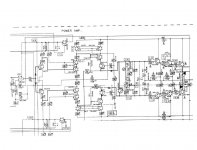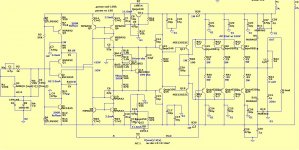Well, to make matters worse somewhat --- as I recall, when I put together the topology often shown and used here (not the same as an IC CFA topology -Elantec etal) I found, experimentally, that it would behave a little differently if the circuit Z values were high and if they were low. When low, the classical CFA characteristic started to show more... current control. [same supply voltages]
I used low circuit Z values for several reasons.... one for low noise and also so that parasitic and stray C would have little effect until very high freq. No values higher than 1K Ohm were used.
Thx-RNMarsh
I used low circuit Z values for several reasons.... one for low noise and also so that parasitic and stray C would have little effect until very high freq. No values higher than 1K Ohm were used.
Thx-RNMarsh
Last edited:
Here's an interesting example of what some of you keep on calling 'CFA'- a compound emitter follower with gain output stage with feedback from the Re's .
It is of course true current feedback in the original meaning, as the feedback signal is a sample of the output current.
Comments?
Jan
What commercially available amps are cfa ................?
What commercially available amps are cfa ................?
Accuphase.
What commercially available amps are cfa ................?
There is many commercialy CFA amps, all new Marantzs are based on old Pioneer A400 circuit
Attachments
Some more CFA...
Cyrus III and NAD 214-218 power amps comes to mind. Perhaps oldies but made in volume so there are many out there to audition. I Don't know about the newer designs from these brands.
Cyrus III and NAD 214-218 power amps comes to mind. Perhaps oldies but made in volume so there are many out there to audition. I Don't know about the newer designs from these brands.
There is many commercialy CFA amps, all new Marantzs are based on old Pioneer A400 circuit
You the "man". 😀
A400 is diamond buffered input , Wilson VAS , AND compound Vbe EF3.
My design came to these same "conclusions" without knowledge
of the old pioneer.
Have you seen or heard this amp ??
ps - also notice the a400 is low gain in the power amp - they use an op-amp
for the rest of the gain , like SYN08's "VSOP" .
OS
Last edited:
You the "man". 😀
A400 is diamond buffered input , Wilson VAS , AND compound Vbe EF3.
My design came to these same "conclusions" without knowledge
of the old pioneer.
Have you seen or heard this amp ??
OS
I post this circuit in your thread post #30
http://www.diyaudio.com/forums/solid-state/243842-gla-good-little-amp-survivor-3.html
There is thread with pictures
http://www.diyaudio.com/forums/solid-state/211983-pioneer-a400-power-supply-caps-2.html
Last edited:
Low pass filter in the feedback loop due to the RC (C being parasitic capacitance at the emitter) ?I found, experimentally, that it would behave a little differently if the circuit Z values were high and if they were low.
This imply we have to compensate the VAS more, so, reduced slew-rate/current on demand...bandwidths etc.
We can do the same with CF OPAs, it is obvious the OPA don't change its nature 🙂
Because it was the most expensive ? ;-)Thanks guys, but the only one of interest is the Accuphase ....
My favorite Studer CFA was not uninteresting. The Marantz neither at its time, for a mass market midfi product.. (on my point of view, of course)
Thanks guys, but the only one of interest is the Accuphase ....
Try Accuphase p700 with apogee scintilla, just compare with your current setup.
Because it was the most expensive ? ;-)
My favorite Studer CFA was not uninteresting. The Marantz neither at its time, for a mass market midfi product.. (on my point of view, of course)
You take 20th century "mid-fi" , apply 21st century components
and engineering - you have "audiophile".
2500$ H/K 990 is a leach with a thermaltrak OPS , for example.
OS
🙂You take 20th century "mid-fi" , apply 21st century components and engineering - you have "audiophile".
wilson's controversial amp...
amp asc. files are below.
Just for fun , remove all compensation (C5/6). She still runs. 😀
Remove a current source , CF keeps offset below 5 V .. speakers
would not burn. A Very" idiotproof" design , as well.
By swapping models , "critical" matching would not be an issue.
As easy (or easier) than most of my VFA designs.
Off to the "cave" to layout in sprint ..... 😎
I'm going to make this one look "eerie"/controversial (UV led CCS's) ....
OS
amp asc. files are below.
Just for fun , remove all compensation (C5/6). She still runs. 😀
Remove a current source , CF keeps offset below 5 V .. speakers
would not burn. A Very" idiotproof" design , as well.
By swapping models , "critical" matching would not be an issue.
As easy (or easier) than most of my VFA designs.
Off to the "cave" to layout in sprint ..... 😎
I'm going to make this one look "eerie"/controversial (UV led CCS's) ....
OS
Attachments
Last edited:
amp asc. files are below.
Just for fun , remove all compensation (C5/6). She still runs. 😀
Remove a current source , CF keeps offset below 5 V .. speakers
would not burn. A Very" idiotproof" design , as well.
By swapping models , "critical" matching would not be an issue.
As easy (or easier) than most of my VFA designs.
Off to the "cave" to layout in sprint ..... 😎
I'm going to make this one look "eerie"/controversial (UV led CCS's) ....
OS
Beter use ksa992/ksc1845 instead mpsa42/92 in place Q5,Q6,Q8 and Q9.
Beter use ksa992/ksc1845 instead mpsa42/92 in place Q5,Q6,Q8 and Q9.
Excellent idea .
Those devices only see 5-6V , and are the ones thermally coupled both
in the schema and photos.
Q7 and 10 would be good candidates for the fairchild ksa1381/ksc3503.
Nothing would have to be heatsinked , all run under 4ma.
OS
Thanks Pavel ......
Accuphase is high end amp but not the only ones, Myryad comes to mind, they have been using CFA since late 80s. One of the 2 Sony high end amps is a CFA. Pioneer first used this topology in 1978 (MZ1) in the top of the range amps, they have a couple of US patents on it. They were also the pioneers of the CFA topology using JFets as inputs and hold patents with regard to these. They have too many CFAs to mention all here.
The complete ranges of NAD amplifiers except for some AV recievers are since about 2003 all CFA designs.
Renkus Hein which is PA manufacturer uses CFA.
I can carry on with the list but it will get very long.
Last edited:
Low pass filter in the feedback loop due to the RC (C being parasitic capacitance at the emitter) ?
This imply we have to compensate the VAS more, so, reduced slew-rate/current on demand...bandwidths etc.
We can do the same with CF OPAs, it is obvious the OPA don't change its nature 🙂
The operation going from low current/high Z circuit to high current/low z circuit values/operation with same topology caused the circuit to behave more like CFA in regards to peaking/gain/distortion (both lightly loaded output - this was a line level amp) etc. Might be able to SIM and see now?
But I am going by memory from 35 years ago.... might be something else.
Thx-RNMarsh
Last edited:
- Home
- Amplifiers
- Solid State
- CFA Topology Audio Amplifiers

